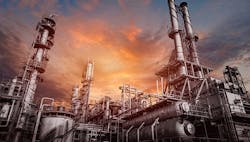Some classes of equipment have a disproportionate effect on overall energy efficiency. Foremost among these is fired equipment, which includes furnaces and boilers.
Furnaces and boilers are an integral part of most sites in the process industries. Furnaces are commonly used to heat and vaporize hydrocarbon feeds. Boilers, in contrast, produce only steam. However, the classification isn’t always clear-cut, as many furnaces incorporate convection banks that produce steam, in addition to their hydrocarbon heating duty. An important example of this is the pyrolysis furnace used in ethylene plants, where the furnace steam production is an important part of the overall process.
Energy efficiency (η) can be defined by a simple equation: η = (Useful energy)/(Energy supplied)
The useful energy is the amount of heat delivered by the fired equipment for “useful” purposes, such as heating process streams or making steam. The energy supplied is the heat content of fuel that is burned. However, this can be defined in two different ways. The higher heating value (HHV) is the thermodynamic heat of combustion, or the enthalpy difference between all combustion products, including condensed water, and the fuel and oxygen before combustion, at a standard temperature (commonly 77°F). The lower heating value (LHV) subtracts the heat needed to condense the water vapor component of the combustion product — basically implying that energy can’t be recovered by condensing water in the stack gas. When discussing the efficiency of fired equipment, it’s important to indicate which heating value is being used. In the United States, boiler efficiencies usually are calculated using HHV, whereas Europe uses LHV, which yields a higher numerical value for the efficiency. Many modern furnaces have a net LHV efficiency above 94%, with a stack temperature of about 230°F for furnaces that burn clean fuel gas. Boiler efficiencies typically are lower.
Three main factors impact the efficiency of furnaces and boilers, although the largest inefficiencies are usually due to the first two: temperature losses and combustion losses.
1. Temperature losses. How hot is the stack gas?
Low stack temperatures result in high efficiency. However, the absorption of heat from stack gases is limited by two main factors:
i. There is a tradeoff between the cost of the convection bank (heat exchanger) and the value of the energy savings as the stack temperature is reduced. For example, if the feed comes into the convection section of a large furnace at 230°F, the minimum economical stack temperature is typically between 260°F and 270°F.
ii. The stack temperature must generally remain above the condensation temperature of the acid components of the combustion products — the acid gas dew point. The acid dewpoint is very sensitive to the amount of sulfur in the feed; it typically lies between 220°F and 340°F. If the acids condense, they are very corrosive, and can rapidly damage the equipment.
2. Combustion losses. Is too much air used (excess oxygen), or too little air (excess fuel)?
Both too much and too little air reduce efficiency. If too much air goes to the firebox, the stack gas flow increases, so at any given stack temperature, the stack gas carries more heat out of the stack. Conversely, if too little air goes to the firebox, incomplete combustion will occur, wasting fuel. Furthermore, incomplete combustion can lead to fires in other parts of the furnace or boiler and also can result in high emissions of toxic carbon monoxide from the stack.
3. Shell losses. How much is lost through the shell or casing of the fired equipment?
These losses are a function of the equipment’s insulation and sealing. For modern furnaces and boilers, the shell losses are generally small (0.5–1.0%).
In boilers, and in furnaces that produce steam, there is a fourth type of loss to consider — blowdown loss. Typically, between 2% and 5% of the water supplied for steam production is discarded in blowdown streams to remove dissolved solids and other contaminants. The heat content of the blowdown typically is about 1% of the heat from fired fuel.
Additional information:
Alan Rossiter & Beth Jones, ‘Energy Management and Efficiency for the Process Industries,’ AIChE/John Wiley & Sons, Inc., Hoboken, New Jersey, 2015, Chapter 9.
About the Author

Alan Rossiter
Energy Columnist
Alan Rossiter is a former contributor for Chemical Processing's Energy Saver column. He has more than 35 years of experience in process engineering and management, including eight years in plant technical support, design and research with Imperial Chemical Industries (ICI, United Kingdom) and nine years in energy efficiency and waste minimization consulting with Linnhoff March, before starting his own business. In 2019 he joined the University of Houston as Executive Director, External Relations for UH Energy. He is a chartered engineer (U.K.) and a registered professional engineer in the state of Texas. His latest book, Energy Management and Efficiency for the Process Industries, coauthored with Beth Jones, was published by John Wiley & Sons in 2015. He is a Fellow of the American Institute of Chemical Engineers and a Past Chair of the South Texas Section of the AIChE.
